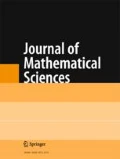We consider the Tribin function and its generalization based on the \( {Q}_s^{\ast } \) -representation of real numbers, which is an s-symbol encoding of numbers and, generally speaking, a nonself-similar generalization of the s-adic representation. By definition, the function f associates the number \( x={\varDelta}_{\upalpha_1{\upalpha}_2\dots {\upalpha}_n\dots}^{Q_s^{\ast }}, \) where αn ∈ L ≡ As × As × … × As × … and As = {0, 1, …, s − 1} is an alphabet, s ≥ 3; with the number \( y=f(x)={\varDelta}_{\upgamma_1{\upgamma}_2\dots {\upgamma}_n\dots}^{G_2^{\ast }}, \)
where the \( {G}_2^{\ast } \) -representation of numbers has the two-symbol alphabet A2 = {0, 1}. We prove that the function f is well-defined, continuous, and nowhere monotone. Its variational properties are also analyzed.
Similar content being viewed by others
References
M. V. Prats’ovytyi, “Nowhere monotonic singular functions,” Nauk. Chasopys. Nats. Ped. Univ. Drahomanova, Ser. 1, Fiz.-Mat. Nauk., No. 12, 24–36 (2011).
M. V. Prats’ovytyi and A. V. Kalashnikov, “Self-affine singular and nowhere monotone functions related to the Q-representation of real numbers,” Ukr. Mat. Zh., 65, No. 3, 405–417 (2013); English translation: Ukr. Math. J., 65, No. 3, 448–462 (2013).
M. V. Prats’ovytyi and N. A. Vasylenko, “One family of continuous nowhere monotonic functions with fractal properties,” Nauk. Chasopys. Nats. Ped. Univ. Drahomanova, Ser. 1, Fiz.-Mat. Nauk., No. 14, 176–188 (2013).
M. Pratsiovytyi and N. Vasylenko, “Fractal properties of functions defined in terms of Q-representation,” Internat. J. Math. Analysis, 7, No. 61-64, 3155–3169 (2013).
M. V. Prats’ovytyi and N. A. Vasylenko, “One family of continuous functions with everywhere dense set of singularities,” Nauk. Chasopys. Nats. Ped. Univ. Drahomanova, Ser. 1, Fiz.-Mat. Nauk., No. 12, 152–167 (2011).
M. V. Prats’ovytyi and N. A. Vasylenko, “Distributions of probabilities on graphs for one class of nowhere monotonic functions,” in: Proc. of the Institute of Applied Mathematics and Mechanics, Ukrainian National Academy of Science [in Ukrainian], Kyiv, 26 (2013), pp. 159–171.
S. B. Kozyrev, “On the topological density of winding functions,” Mat. Zametki, 33, Issue 1, 71–76 (1983).
I. V. Zamrii and M. V. Prats’ovytyi, “Singularity of the digit inversor for the Q3-representation of the fractional part of a real number, its fractal and integral properties,” Nelin. Kolyv., 18, No. 1, 55–70 (2015); English translation: J. Math. Sci., 215, No. 3, 323–340 (2016).
M. V. Prats’ovytyi, Fractal Approach to the Investigation of Singular Distributions [in Ukrainian], National Pedagogic University, Kyiv (1998).
M. V. Prats’ovytyi and O. V. Svynchuk, “Spread of values of a Cantor-type fractal continuous nonmonotone function,” Nelin. Kolyv., 21, No. 1, 116–130 (2018); English translation: J. Math. Sci., 240, No. 3, 342–357 (2019).
M. V. Prats’ovytyi, “Calculus systems with variable bases and variable alphabet (or expansion of numbers in Cantor series),” Student. Fiz.-Mat. Etyudy, No. 8, 6–18 (2009).
M. V. Prats’ovytyi, Geometry of the Classical Binary Representation of Real Numbers [in Ukrainian], National Pedagogic University, Kyiv (2012).
N. V. Pratsevityi, “Continuous Cantor projectors,” in: Methods for the Investigation of Algebraic and Topological Structures [in Russian], Kiev National Pedagogic University, Kiev (1989), pp. 95–105.
A. F. Turbin and N. V. Pratsevityi, Fractal Sets, Functions, and Distributions [in Russian], Naukova Dumka, Kiev (1992).
K. A. Bush, “Continuous functions without derivatives,” Amer. Math. Monthly, 59, No. 4, 222–225 (1952).
W. Wunderlich, “Eine ¨uberall stetige und nirgends differenzierbare Funktion,” Elem. Math., 7, No. 4, 73–79 (1952).
V. V. Koval, “Self-affine graphs of functions,” Nauk. Chasopys. Nats. Ped. Univ. Drahomanova, Ser. 1, Fiz.-Mat. Nauk., No. 5, 292–299 (2004).
O. B. Panasenko, “Fractal dimension of the graphs of continuous Cantor projectors,” Nauk. Chasopys. Nats. Ped. Univ. Drahomanova, Ser. 1, Fiz.-Mat. Nauk., No 9, 104–111 (2008).
M. V. Prats’ovytyi, “Fractal properties of one continuous nowhere differentiable function,” Nauk. Chasopys. Nats. Ped. Univ. Drahomanova, Fiz.-Mat. Nauk., No. 3, 351–362 (2002).
G. M. Torbin and N. V. Pratsevityi, “Random variables with independent Q*-signs,” in: Random Evolutions: Theoretical and Applied Problems [in Russian], Kiev (1992), pp. 95–104.
A. Ya. Khinchin, Continued Fractions [in Russian], Nauka, Moscow (1978).
M. Kac, Statistical Independence in Probability Analysis and Number Theory, The Mathematical Association of America (1959).
Author information
Authors and Affiliations
Corresponding author
Additional information
Translated from Neliniini Kolyvannya, Vol. 22, No. 3, pp. 380–390, July–September, 2019.
Rights and permissions
About this article
Cite this article
Prats’ovytyi, M.V., Baranovs’kyi, O.M. & Maslova, Y.P. Generalization of the Tribin Function. J Math Sci 253, 276–288 (2021). https://doi.org/10.1007/s10958-021-05227-3
Received:
Published:
Issue Date:
DOI: https://doi.org/10.1007/s10958-021-05227-3


